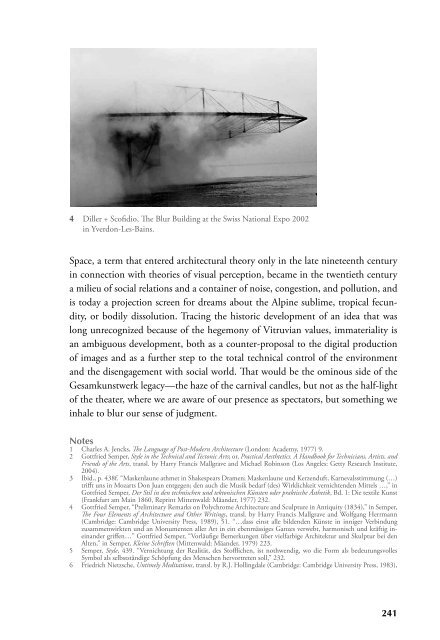The Death and Life of the Total Work of Art – Henry van de Velde and the Legacy of a Modern Concept
ISBN 978-3-86859-261-0
ISBN 978-3-86859-261-0
You also want an ePaper? Increase the reach of your titles
YUMPU automatically turns print PDFs into web optimized ePapers that Google loves.
4 Diller + Sc<strong>of</strong>idio, <strong>The</strong> Blur Building at <strong>the</strong> Swiss National Expo 2002<br />
in Yverdon-Les-Bains.<br />
Space, a term that entered architectural <strong>the</strong>ory only in <strong>the</strong> late nineteenth century<br />
in connection with <strong>the</strong>ories <strong>of</strong> visual perception, became in <strong>the</strong> twentieth century<br />
a milieu <strong>of</strong> social relations <strong>and</strong> a container <strong>of</strong> noise, congestion, <strong>and</strong> pollution, <strong>and</strong><br />
is today a projection screen for dreams about <strong>the</strong> Alpine sublime, tropical fecundity,<br />
or bodily dissolution. Tracing <strong>the</strong> historic <strong>de</strong>velopment <strong>of</strong> an i<strong>de</strong>a that was<br />
long unrecognized because <strong>of</strong> <strong>the</strong> hegemony <strong>of</strong> Vitruvian values, immateriality is<br />
an ambiguous <strong>de</strong>velopment, both as a counter-proposal to <strong>the</strong> digital production<br />
<strong>of</strong> images <strong>and</strong> as a fur<strong>the</strong>r step to <strong>the</strong> total technical control <strong>of</strong> <strong>the</strong> environment<br />
<strong>and</strong> <strong>the</strong> disengagement with social world. That would be <strong>the</strong> ominous si<strong>de</strong> <strong>of</strong> <strong>the</strong><br />
Gesamkunstwerk legacy—<strong>the</strong> haze <strong>of</strong> <strong>the</strong> carnival c<strong>and</strong>les, but not as <strong>the</strong> half-light<br />
<strong>of</strong> <strong>the</strong> <strong>the</strong>ater, where we are aware <strong>of</strong> our presence as spectators, but something we<br />
inhale to blur our sense <strong>of</strong> judgment.<br />
Notes<br />
1 Charles A. Jencks, <strong>The</strong> Language <strong>of</strong> Post-Mo<strong>de</strong>rn Architecture (London: Aca<strong>de</strong>my, 1977) 9.<br />
2 Gottfried Semper, Style in <strong>the</strong> Technical <strong>and</strong> Tectonic <strong>Art</strong>s; or, Practical Aesthtetics. A H<strong>and</strong>book for Technicians, <strong>Art</strong>ists, <strong>and</strong><br />
Friends <strong>of</strong> <strong>the</strong> <strong>Art</strong>s, transl. by Harry Francis Mallgrave <strong>and</strong> Michael Robinson (Los Angeles: Getty Research Institute,<br />
2004).<br />
3 Ibid., p. 438f. “Maskenlaune athmet in Shakespears Dramen; Maskenlaune und Kerzenduft, Karnevalsstimmung (…)<br />
trifft uns in Mozarts Don Juan entgegen; <strong>de</strong>n auch die Musik bedarf (<strong>de</strong>s) Wirklichkeit vernichten<strong>de</strong>n Mittels …,” in<br />
Gottfried Semper, Der Stil in <strong>de</strong>n technischen und tektonischen Künsten o<strong>de</strong>r praktische Äs<strong>the</strong>tik, Bd. 1: Die textile Kunst<br />
(Frankfurt am Main 1860, Reprint Mittenwald: Mä<strong>and</strong>er, 1977) 232.<br />
4 Gottfried Semper, “Preliminary Remarks on Polychrome Architecture <strong>and</strong> Sculpture in Antiquity (1834),” in Semper,<br />
<strong>The</strong> Four Elements <strong>of</strong> Architecture <strong>and</strong> O<strong>the</strong>r Writings, transl. by Harry Francis Mallgrave <strong>and</strong> Wolfgang Herrmann<br />
(Cambridge: Cambridge University Press, 1989), 51. “…dass einst alle bil<strong>de</strong>n<strong>de</strong>n Künste in inniger Verbindung<br />
zusammenwirkten und an Monumenten aller <strong>Art</strong> in ein ebenmässiges Ganzes verwebt, harmonisch und kräftig inein<strong>and</strong>er<br />
griffen…” Gottfried Semper, “Vorläufige Bemerkungen über vielfarbige Architektur und Skulptur bei <strong>de</strong>n<br />
Alten,” in Semper, Kleine Schriften (Mittenwald: Mä<strong>and</strong>er, 1979) 223.<br />
5 Semper, Style, 439. “Vernichtung <strong>de</strong>r Realität, <strong>de</strong>s St<strong>of</strong>flichen, ist nothwendig, wo die Form als be<strong>de</strong>utungsvolles<br />
Symbol als selbstständige Schöpfung <strong>de</strong>s Menschen hervortreten soll,” 232.<br />
6 Friedrich Nietzsche, Untimely Meditations, transl. by R.J. Hollingdale (Cambridge: Cambridge University Press, 1983),<br />
241


















